Best cheap smart trainers 2024: get connected without the cost
Getting started with indoor training doesn't need to cost a fortune if you use one of the best cheap smart trainers


Recent updates
17th October 2024: Removal of the Zwift Hub. This has been superseded by the Wahoo Kickr Core fitted with a Zwift One, which we already include in this guide.
The best cheap smart trainers will kick start your indoor training without the expense of many of the best smart turbo trainers or best indoor smart bikes. They are much easier to get the hang of over the best bike rollers.
As indoor cycling has increased in popularity, trainer makers have trickled their technology down to lower price points. Once a premium product, the best budget smart trainers now offer similar functionality at a more reasonable price.
Indoor cycling doesn't just allow you to avoid adverse weather outdoors, it offers many other advantages. Indoors is a more controlled environment where you can concentrate on your riding, not the traffic. The gradients come to you, rather than you needing to seek out a hill to train on and a smart trainer will track your efforts and output without investing in a power meter. The best indoor training apps now make the experience a lot more immersive, letting you ride with other cyclists via online cycling platforms.
Turbo trainers come in two main varieties: wheel-on and wheel-off, also called direct-drive. As the names suggest wheel-on places the rear wheel onto the trainer and the tyre runs on a roller connected to the flywheel. Wheel-on or direct-drive mounts your frame directly onto the trainer, allowing for a more accurate transfer of your effort. Why not check which style might be best in our wheel-on vs direct drive comparison guide.
The Quick List
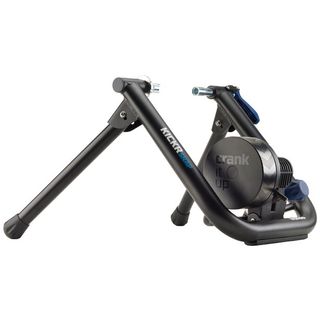
Best wheel on overall
With a max power of 1,500W and a 12% simulated incline the Kickr Snap boasts direct-drive like numbers - and it's almost as smooth.
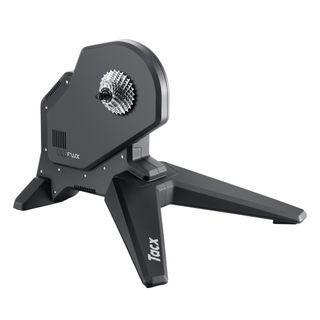
Best direct drive overall
Solidly built, the Flux S is both stable and smooth with a resistance and ride feel that's impressively close to that of Tacx’s flagship trainer.
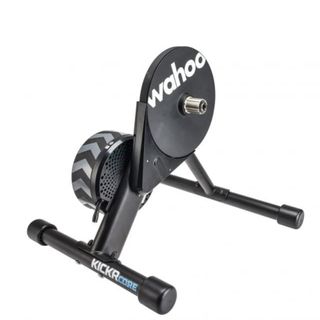
Best value direct drive
While not quite as stable as the Flux S, its greater accuracy makes it an affordable entry point into high-end indoor racing.
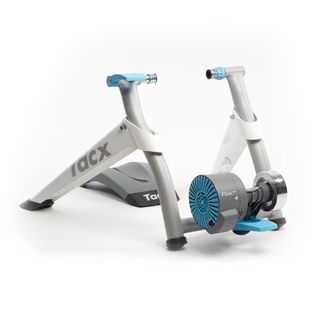
Best value wheel on
Lightweight, easy to set up and stable to ride, the Tacx Flow's delivers 800 watts of resistance, a 6% simulated gradient and a ton of value.
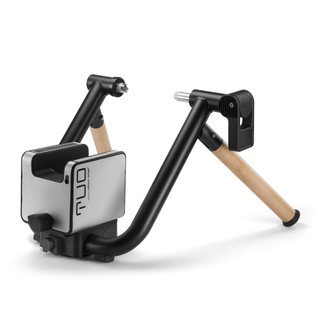
Best compact turbo trainer
The Tuo is light, small and perfectly formed - and then there's those wooden legs. But looks aren't everything - it also delivers 1,300 watts of resistance.
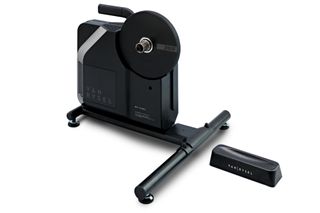
Best for performance direct drive
The Van Rysel D900 offers a lot of performance and value for those new to indoor training. Only let down by minor data inaccuracies.
Best cheap wheel on & direct drive turbo trainers: our picks
You can trust Cycling Weekly.
Best wheel-on overall
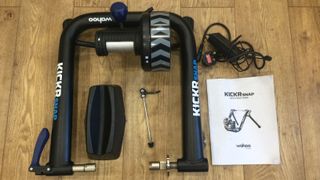
Wahoo Kickr SNAP
Specifications
Reasons to buy
Reasons to avoid
It seems a bit unfair to compare a wheel-on smart trainer to its high-end direct-drive stablemate, but the specification and performance of the Wahoo Kickr SNAP make it hard not to do so. After all, maximum power of 1,500W and a 12% simulated incline are figures that are much more usually seen on direct-drive machines.
The SNAP has a great planted feel and is one of the smoothest wheel-on trainers we've ridden. No, it's not as smooth as a direct-drive turbo but that's a small price to pay given it retails at a third of the price.
At low powers we found the accuracy to be less than the claimed +/- 3% but this improved at higher intensities where these things matter more. Power readings can be a bit spiky, although this largely seemed to be due to an absence of excessive smoothing that more expensive machines are capable of rather than a variation in resistance. There's also a bit of a lag in resistance change at the turn of programmed intervals which we've picked up in other similar-priced machines.
Read our full Wahoo Kickr Snap wheel-on smart trainer review
Best value wheel-on trainer
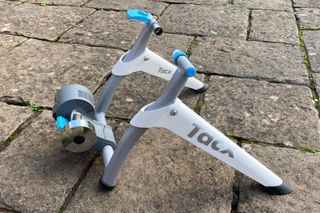
Tacx Flow
Specifications
Reasons to buy
Reasons to avoid
The Tacx Flow is easy to set up, lightweight and can be used unpowered for warm-ups at events. It's very stable, with wide legs and it offers BLE and ANT+ connectivity to transmit speed, power and cadence data to a head unit.
We found that there's a bit of a lag in ramping up resistance both when controlled by Zwift and using ERG mode, which can result in sudden increases when performing certain workouts.
The wheel-on design gives you more limited climb simulation than a direct drive unit at up to 6% and the maximum resistance is 800 watts, with an accuracy of +/- 5%, although we found the Tacx Flow read lower than comparison power meters.
Read our full Tacx Flow wheel-on smart trainer review
Best compact wheel-on trainer
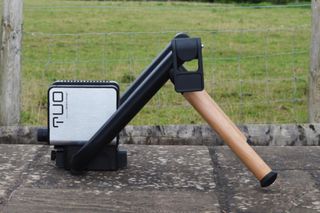
Elite Tuo
Specifications
Reasons to buy
Reasons to avoid
With wooden legs and a square drive unit, the Elite Tuo looks smarter than most trainers. It folds up very small and is lightweight. It's easy to set up your bike on the trainer and thru-axle adapters come with it rather than being an extra.
Elite claims power accuracy of +/-5 per cent, with simulated gradients of up to 10% and 1,300 watts maximum resistance. We thought that the ride was very smooth, with no skips from the roller and power and cadence were accurately measured except in short, high-power sprint efforts.
Read our full Elite Tuo wheel-on smart trainer review
Best overall direct drive trainer
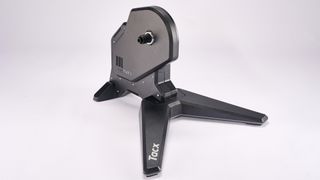
Tacx Flux S
Tacx Flux S
Our expert review:
Specifications
Reasons to buy
Reasons to avoid
First off, this is a really great indoor trainer in so many ways - but with that said, there will be some people for whom it's not quite the right model. Let's break down the details.
With the heaviest flywheel on the test, the Flux S also comes in as the heaviest trainer overall. Couple that with its unique footprint and you’ve got an incredibly stable platform – I’d say even potentially a little more stable than its big brother, the Tacx Neo 2T, which I tested last year.
Likewise, the resistance and ride feel of this entry-level model is impressively close to that of Tacx’s flagship trainer. Changes in gradient were fast and smooth, whilst the resistance remained steady even when climbing at a low speed and low cadence – a challenging combination for a trainer.
The ERG mode coped well with even large differences in power. The resistance would increase quickly - but not cadence crushingly fast, unlike the Elite Zumo. Another point of contrast is that when riding without the ERG mode on or not up any virtual gradients, I was able to push a comfortable cadence at 250w with plenty of sprockets to spare – no danger of spinning out.
In terms of the virtual ride feel and stability of the turbo, this was the best on test – and is better even than some turbos at a higher price point - the Elite Direto unequivocally and, for me, also the Wahoo Kickr – but we’ll get into that in more detail later on.
In having swept up on the fundamentals, it’s fair to ask whether it goes on to clear any of the higher bars – is there any point in buying a more expensive model? Sadly, yes there is. But only for people with quite specific use cases.
First, the accuracy. Rated at ±3% this is the same as the Zumo. But it’s worth pointing out this doesn’t meet the ±2% cut-off for the upper echelons of Zwift racing. For most people, this isn’t a consideration – the majority of Zwift users aren’t racers, and it’s only a very small subsection of them who would be racing in those categories, but it’s worth being aware of.
Similarly, for challenges such as a ‘virtual’ everesting, the rules stipulate that the realism must be set to 100%. If you’re planning on using the Alpe du Zwift for your attempt, then you’re going to fall foul of ‘the rules’, as the maximum gradient there is 14%.
Again both these points won’t matter to most people, and is part of the reason why this is the trainer that we would recommend overall. But just because this trainer is so good, it is worth being aware of exactly where the limitations are, so that there aren’t any surprises.
The other consideration is that this is not a trainer for moving about or stowing away. The legs don’t fold and it is really very heavy.
Best value direct drive trainer

Wahoo Kickr Core
Wahoo Kickr Core
Our expert review:
Specifications
Reasons to buy
Reasons to avoid
The Wahoo Kickr Core and the Tacx Flux S line up for a particularly interesting contrast. It’s almost like a Venn diagram, but where the two circles have been pushed together so that it’s just a thin sliver on either side where there isn’t any overlap.
We’ll blast through the fundamentals pretty quickly again because, like the Tacx Flux S, the Wahoo Kickr Core executes these so well that it’s worth spending a bit more time on the hair-splitting points of differentiation.
Starting with the ride feel, I’d actually argue that the Core does better (in some aspects) than the flagship Kickr V5 I tested last year (although this model has now been surpassed by the V6).
How can this be? Well, I assume that it’s down to the weight of the flywheels. With the Kickr V5, it always felt like there was a great deal of inertia to spin up when accelerating – for me, it was a little less like riding out on the open road and a little more like that of a ‘spin bike’, with their huge fixed-gear flywheels.
True, the Tacx Neo 2T itself boasts an electromagnetic flywheel that can simulate a weight of up to 125kg, but it’s not simulating that all the time, and, in my opinion, it has more of a ‘road feel’ than that of a Kickr V5.
Coming back to the Kickr Core, with the flywheel being 5.4kg compared to the 7.3kg of the V5, the sensation of acceleration felt just a bit more natural for me. Although this should be heavily caveated with the point that if you’re a heavier rider, you might well find the opposite.
In terms of the response to sudden changes in gradient and interval sessions with large differentials of power in ERG mode, the resistance changed smoothly and quickly. It also didn’t have a particular propensity to ‘death spiral’ and force you into pushing an ever lower cadence – all very good and very similar to the Kickr V5.
As mentioned, the Kickr Core does manage to hit points that the Tacx Flux S has missed. With an accuracy of ±2%, this is one of the cheaper entry points to high-end indoor racing. Plus, with a maximum gradient of 16%, you’ll be able to cut your vEversting teeth on the Alp du Zwift and feel every ramp. It’s also an easier trainer to move around than the Flux S and takes up less space.
However, there are points which do let it down in comparison to the Flux S. First is the stability: these two-bar designs are much less stable than three-leg versions – and the Flux is particularly solid.
Then there’s the price. £100 more might not be too much when choosing between bikes, but it’s a sizable chunk when it comes to turbos.
Best value for performance

Van Rysel D900
Our expert review:
Specifications
Reasons to buy
Reasons to avoid
If all you saw of the Van Rysel D900 was its spec sheet, you would be forgiven to think it should be a price twice what it is. Decathlon (owners of the Van Rysel brand) had one clear objective with the D900, to take on the Wahoo Kickr and Tacx Neo 2T but at a much more affordable cost.
Initially, during our testing, it seemed like Decathlon had hit the nail on the head. The D900 feels very stable and jumping straight into both ERG and SIM modes proved it had what it took to compete. Once I started digging down into the details, that's when I started to see why the D900 is so much cheaper.
After some cross-checking with my 4iii dual-sided crank-based power meter, it appeared the power accuracy wasn't within the +/- 2% Decathlon claims. My testing shows it was actually nearer +/- 12%. Which in my experience is unusual for a power meter based at the hub, as they tend to read much lower. Fortunately, despite the discrepancies the data is consistent. So, with a little bit of maths, you could continue to track your progress and performance.
The Van Rysel D900 does what it set out to do, compete with the best. Assuming don't mind the occasional bit of maths or take your E-racing too seriously. I think the one bit of maths we can all do though is the cost saving over the Wahoo and Tacx.
Read our full Van Rysel D900 turbo trainer review
How we test
FAQs about cheap smart trainers
If you're not sure how to decide on the best budget smart trainer for your needs, out buyer's guide will answer some key questions. For further advice, it's worth reading our guide to the best smart trainers that we've tested here at Cycling Weekly.
What makes a trainer smart?
To be useful, a trainer has to offer variable resistance. Yes, you can spin away and varying your cadence will give you some training benefits, but working against varying resistance will give you more.
A non-smart trainer will give you an adjustment knob to up or reduce the resistance yourself. But a smart trainer will vary resistance automatically, which opens up a much more interesting experience when you link your trainer up to Zwift, Wahoo X or any one of a number of indoor training apps.
Your smart trainer will have Bluetooth and ANT+ connectivity to a cycling computer, smartphone, computer or other device built in, so you can link it up, collect up the other essentials for indoor training and start to ride.
Is wheel-on or direct drive better?
The cheapest smart trainers are usually wheel-on options. They have the advantage that you can just anchor your bike in the trainer and start to ride. But among their disadvantages is that the trainer can wear through a rear tyre quickly, so you may need a harder compound indoor cycling tyre. The power measurement is likely to be less accurate than a direct drive model too.
A cheap direct drive trainer will give you more reliable power figures. Although it probably won't be as accurate as a premium model, a figure of +/- 3 per cent in power readings isn't going to make a lot of difference to your training and racing. You'll have to buy a cassette to hook up to your bike, but you'll save wear on your rear tyre.
What more do I get from a premium smart trainer?
An affordable smart trainer will give you the same basics of resistance controlled by a programme like Zwift as a more expensive smart trainer.
As mentioned above, the absolute power accuracy may not be as precise as a premium smart trainer, but it's not going to be enormously inconsistent. If you have a power meter on your outdoor bike, you can always use that for your indoor power measurement, so you get consistent results indoors and out.
Brands are adding new functionality to their premium models. In the case of the Tacx Neo 2T, this includes simulated cobbles and both the Neo 2T and the Wahoo Kickr, (but not the brand's more affordable smart trainers), provide side-to-side movement for a more realistic ride feel.
Wahoo has now added WiFi to the updated Kickr too, so you can network it directly to the internet, increasing data bandwidth and allowing automatic firmware updates.
Our testing of these smart trainers involved many hours staring at our Zwift avatars, riding the most varied routes that Watopia has to offer. The trainers were tested for ease of set-up, connectivity, storage and portability
Accuracy.
Perhaps even more important than any of those though is the less measurable 'ride feel'. This can make or break a turbo session so is hugely important and roughly correlates to how similar it feels to riding a normal bike. The better the 'ride feel' the more enjoyable it is and therefore you are far more likely to hit the turbo rather than the sofa.
Get The Leadout Newsletter
The latest race content, interviews, features, reviews and expert buying guides, direct to your inbox!
Paul started writing for Cycling Weekly in 2015, covering cycling tech, new bikes and product testing. Since then, he’s reviewed hundreds of bikes and thousands of other pieces of cycling equipment for the magazine and the Cycling Weekly website.
He’s been cycling for a lot longer than that though and his travels by bike have taken him all around Europe and to California. He’s been riding gravel since before gravel bikes existed too, riding a cyclocross bike through the Chilterns and along the South Downs.
- Sonny EvansWriter
- Matt Ischt-BarnardEcomm and Tech Writer
-
 Is Mathieu van der Poel winning races “in zone 2” helping or hindering cyclo-cross?
Is Mathieu van der Poel winning races “in zone 2” helping or hindering cyclo-cross?The Dutch world champion has turned up off-road now, and immediately won twice. Is this fun?
By Adam Becket Published
-
 Tom Pidcock joined by brother Joe at Q36.5 Pro Cycling as team finalised for 2025
Tom Pidcock joined by brother Joe at Q36.5 Pro Cycling as team finalised for 2025Pidcock's coach Kurt Bogaerts also confirmed as team's head of technical performance
By Adam Becket Published